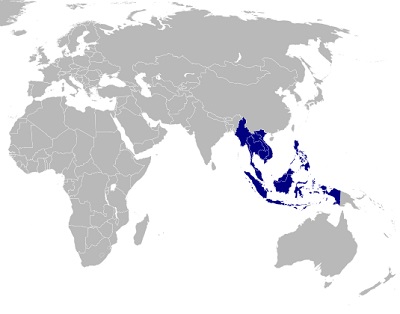Association of Southeast Asian Nations are increasingly using smartphones to shop and buy.
A recent study conducted on behalf of Visa has shown that consumers in Association of Southeast Asian Nations (A.S.E.A.N.) member countries are using m-commerce on an increasing basis for making purchases of products and services online.
Consumers in these countries are also using their mobile devices to make bill payments instead of using PCs.
The “2015 Regional eCommerce Monitor Survey for Asia-Pacific” from Visa determined that the A.S.E.A.N. countries are now using m-commerce at a rate that is 22 percent larger than it was last year. The report was based on an analysis of the results of a survey in which there were 11,760 participants. The respondents were between 15 and 55 years old and lived within any of 13 different Asia-Pacific countries, including the A.S.E.A.N. countries of Thailand, Malaysia, Indonesia, Singapore, and Vietnam.
The largest amount of growth in the use of m-commerce over the last year were in Indonesia, mainland China and Taiwan.
 In Indonesia, 36 percent of respondents said that they were using mobile commerce, while 34 percent of those from mainland China were shopping over their smartphones and tablets. In Taiwan, that figure was not far behind at 28 percent.
In Indonesia, 36 percent of respondents said that they were using mobile commerce, while 34 percent of those from mainland China were shopping over their smartphones and tablets. In Taiwan, that figure was not far behind at 28 percent.
The Visa Asia Pacific regional director for e-commerce, Conor Lynch, stated that “The results of the 2015 survey show that making purchases on-the-go through mobile devices is becoming the norm in the Asia-Pacific.” He also added that as the comfort level increases among consumers with regards to using mobile devices to learn more about products they’d like to purchase and to actually buy them, it won’t be long before mobile commerce overtakes traditional online shopping over desktops and laptops among retail stores.
In A.S.E.A.N. countries, there is a very powerful drive toward the use of m-commerce as there is considerable ease of access over mobile and there is a significant push in the real world to use smartphones for in response to advertisements. Many billboards, print and television ads encourage shoppers to interact with them by way of their devices. This, according to Sandy Shen the research director at Gartner.
A new report from the research firm has shown that by the close of 2016, sales will break the $142 billion mark.
Forrester Research has now released a new report that it has entitled its “U.S. Mobile Phone and Tablet Commerce Forecast, 2015 to 2020” and within it, it has shown that the close of this year will break $115 billion in transactions and they will only head upward from there.
The report also goes on to say that by the end of next year, m-commerce sales will explode past $142 billion.
Principal analyst at Forrester Research, Sucharita Mulpuru, who is also the firm’s vice president, explained that “We project that mobile phones will generate 15 percent of eCommerce sales by 2020, and tablets will generate 33 percent of eCommerce sales in the same time frame.” She also explained that as smartphones are rapidly becoming a main computing device for many consumers, it is surprising that those mobile commerce figures aren’t even higher than they already are.
The report from Forrester has placed the spotlight on many of the challenges creating a barrier to mobile commerce.
 Although merchants have said that about a third of its current online traffic comes from mobile devices, the number of actual sales that are occurring over smartphones and tablets is only 11 percent. This shows that while people are visiting sites to check out brands, products, and stores, they aren’t actually using those same gadgets to make their purchases. When they do buy, it’s more likely to be in person or over a laptop.
Although merchants have said that about a third of its current online traffic comes from mobile devices, the number of actual sales that are occurring over smartphones and tablets is only 11 percent. This shows that while people are visiting sites to check out brands, products, and stores, they aren’t actually using those same gadgets to make their purchases. When they do buy, it’s more likely to be in person or over a laptop.
Mulpuru stated that “Shoppers experience slow download speeds on smartphones in particular, and few retailers have managed to increase their mobile conversion rates over the years.” Most of the sales that are occurring over m-commerce are happening within three primary categories, which means that the majority of sectors remain underpenetrated and still have a great deal of unused potential. Those categories will need to go a long way before they will be able to experience success over that channel.
At the same time, there are also retailers who have been successful by way of mobile commerce innovations. In Forrester’s report, the firm explained that eBay and Amazon, combined, take in about one third of all shopping that is completed over smartphones and tablets in the United States.
 In Indonesia, 36 percent of respondents said that they were using mobile commerce, while 34 percent of those from mainland China were shopping over their smartphones and tablets. In Taiwan, that figure was not far behind at 28 percent.
In Indonesia, 36 percent of respondents said that they were using mobile commerce, while 34 percent of those from mainland China were shopping over their smartphones and tablets. In Taiwan, that figure was not far behind at 28 percent.
 Although merchants have said that about a third of its current online traffic comes from mobile devices, the number of actual sales that are occurring over smartphones and tablets is only 11 percent. This shows that while people are visiting sites to check out brands, products, and stores, they aren’t actually using those same gadgets to make their purchases. When they do buy, it’s more likely to be in person or over a laptop.
Although merchants have said that about a third of its current online traffic comes from mobile devices, the number of actual sales that are occurring over smartphones and tablets is only 11 percent. This shows that while people are visiting sites to check out brands, products, and stores, they aren’t actually using those same gadgets to make their purchases. When they do buy, it’s more likely to be in person or over a laptop.